Introduction
Iron is one of the most essential metals in the world, forming the backbone of industrialization, infrastructure, and technological advancement. As the primary component of steel, iron is crucial for construction, manufacturing, transportation, and energy production. The global iron and steel market was valued at $1.7 trillion in 2023 and is projected to grow at a CAGR of 3.5% from 2024 to 2030 (Grand View Research, 2024). Its widespread use makes iron a key driver of economic growth and national development.
Key Contributions of Iron to National Development
1. Infrastructure and Construction
Iron, in the form of steel, is fundamental to modern infrastructure. It is used in:
- Bridges, skyscrapers, and highways – Provides strength and durability.
- Residential and commercial buildings – Reinforced concrete (using steel rebars) ensures structural integrity.
- Urban development – Metro rails, airports, and ports rely heavily on steel.
According to the World Steel Association (2024), over 1.9 billion metric tons of steel were produced globally in 2023, with China, India, and the U.S. leading production.
2. Industrial and Manufacturing Growth
Iron and steel are vital for multiple industries:
- Automobiles – Steel accounts for ~50% of a vehicle’s weight (International Energy Agency, 2023).
- Machinery and equipment – Agricultural, mining, and industrial machines depend on steel.
- Consumer goods – Appliances, tools, and packaging materials use steel.
Countries with strong steel industries, such as China, Japan, and Germany, have robust manufacturing sectors, contributing significantly to GDP.
3. Job Creation and Economic Impact
The iron and steel industry supports millions of jobs worldwide:
- Direct employment in steel production exceeds 6 million jobs globally (ILO, 2023).
- Indirect employment in construction, mining, and logistics adds millions more.
- Developing nations like India and Nigeria are expanding steel production to boost employment and reduce import dependency.
4. Transportation and Energy
Iron is critical for:
- Railways – Steel tracks and train components ensure safe and efficient transport.
- Shipbuilding – Over 90% of ship structures are made of steel (Maritime Executive, 2024).
- Energy infrastructure – Wind turbines, oil pipelines, and power plants rely on steel.
5. Technological and Defense Applications
- Defense & Aerospace – Military vehicles, aircraft, and naval ships require high-grade steel.
- Renewable energy – Solar panel frames and wind turbine towers use steel.
- Innovation in steel alloys – Advanced high-strength steel (AHSS) is revolutionizing automotive and construction industries.
Challenges and Future Outlook
Despite its importance, the iron industry faces challenges:
- Environmental impact – Steel production contributes to ~7-9% of global CO₂ emissions (IEA, 2023).
- Resource depletion – High-quality iron ore reserves are declining.
- Economic fluctuations – Steel prices are volatile due to trade policies and demand shifts.
Sustainable Solutions
- Green steel – Hydrogen-based and electric arc furnace (EAF) steelmaking reduce carbon emissions.
- Recycling – Steel is 100% recyclable, and recycled steel accounts for 40% of production (World Steel Association, 2024).
- Government policies – Initiatives like the EU Carbon Border Tax and India’s National Steel Policy 2023 promote sustainable steel production.
Conclusion
Iron remains a cornerstone of economic and industrial development, enabling infrastructure growth, technological progress, and job creation. As nations transition toward greener production methods, iron and steel will continue to play a pivotal role in shaping sustainable development.
References
- Grand View Research (2024). Iron and Steel Market Report.
- World Steel Association (2024). Steel Statistical Yearbook.
- International Energy Agency (2023). Iron and Steel Technology Roadmap.
- ILO (2023). Employment in the Steel Industry.
Would you like additional details on specific countries or innovations in steel production?





No comment